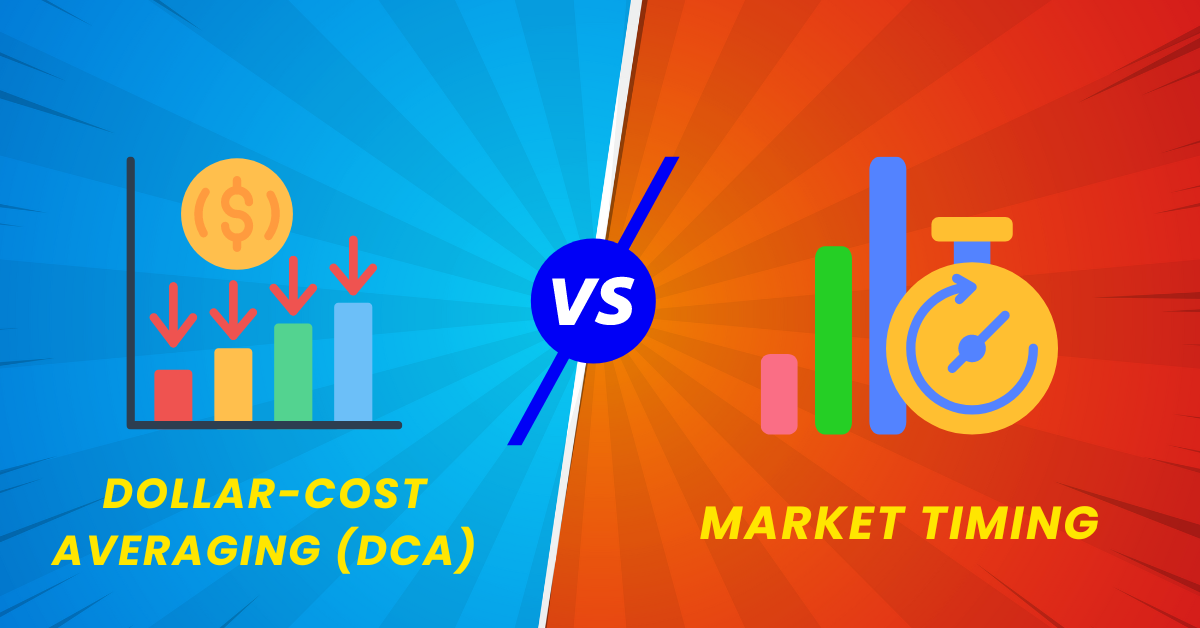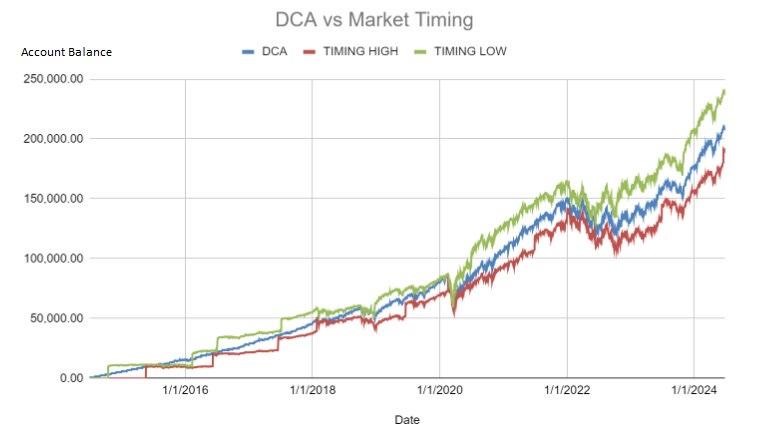Dollar-Cost Averaging vs Market Timing July 19, 2024

Many want to grow their wealth but few know how. We’ve all heard of the recent trends that have minted many millionaires – Crypto, NVDA, GME and Cocoa futures, for instance. In hindsight, if only we had also been on that rocket to the moon, we could have made a fortune for ourselves. However, it’s also well-known that professionals such as fund managers seldom outperform the benchmark, let alone retail investors who fail frequently.
Should retail investors, therefore, consider a passive strategy that generates reasonable returns without having to spend as much time as a full time hedge fund analyst? In this article, we will explore how a seemingly boring strategy compares to market timing.
Setting the Stage
In our study, we take on the persona of an average retail investor with an annual investment budget of S$10,000. This investor either uses a boring Dollar Cost Averaging (DCA) methodology or attempts to time the market.
The chosen instrument for this study is SPY, an ETF that tracks the S&P 500 index. It is selected for its liquidity, extensive historical data, and broad coverage of the US stock market. Whether or not SPY is the best instrument for investment is the topic for another study.
In the DCA scenario, the investor consistently invests an equal portion (S$833) at the start of each month into SPY. Next, to study the effects of market timing, we assume two extreme cases in market timing, (i) always buying at the year’s highest price and (ii) always buying at the year’s lowest price. each with an annual budget of S$10,000.
The study analyses 10 years of SPY data from 1 July 2014 to 30 June 2024 and is split into 10 years for determining the entry points for the market timing scenarios.
Results

Intuitively, the chart above demonstrates that DCA is able to provide returns bounded between the two extreme scenarios of market timing, but with much lower effort. Furthermore, this raises an important consideration: are we confident of our ability to consistently outperform the market, justifying the extra effort over a simpler strategy, or is our time better spent elsewhere?
Now, let’s look at some key statistics:
| Statistics | DCA | TIMING HIGH | TIMING LOW | SPY |
| Compounded Return | 7.67% | 6.65% | 9.10% | 12.76% | Max Draw Down | -33.01% | -33.72% | -31.98% | -33.72% | Max Draw Down Duration | 76 | 119 | 47 | 119 |
The “Compounded Return” has been calculated as the annualised total return on all money invested i.e. on S$100,000. This is a simplistic heuristic to compare the strategies and does not reflect the average return of each dollar invested (which will be higher since money invested earlier would’ve accrued a higher return).
While SPY is shown here for reference, it should not be used for direct comparison as the investor in our study does not have S$100,000 to invest on day 1. Nevertheless, DCA provided a respectable return of 7.67% which is quite considerable on a total return basis.
To put it into perspective, the S$833 invested every month grew to almost S$210,000 in 10 years.
Points to note
Is Dollar Cost Averaging (DCA) the holy grail? Perhaps not. Let’s delve into some critical drawbacks of this study to gain a deeper understanding.
DCA Works Well In Uptrends
One of the key points to note in the above study is that we chose SPY, which has historically been on an uptrend. In short, DCA works well only if the chosen market trends up. For example, if you had started to DCA since 2021, you’d find that returns are subpar for the first two years.
However, it is comforting to note that SPY is generally in an uptrend over the long term as it’s a tracker of the top businesses in the US, which are likely to grow as long as the US continues to be a major global power.
DCA and Cash Flow
DCA offers reasonable long-term returns with minimal effort, providing a viable option for managing cash flow if you lack a clear investment strategy.
However, what if you already have S$100,000 sitting idle in your bank account? DCA doesn’t provide guidance on how to invest a lump sum, which might be better suited to a different investment strategy such as asset allocation—a topic for further exploration.
Dependency on the Underlying Asset
Another limitation relates to the selection of investments. While DCA outlines an approach to market entry, it does not advise on which assets are the best to invest in. SPY has historically been doing well but the future is always uncertain. An alternative approach could be to diversify by selecting a mix of sector-specific or country-specific ETFs.
Conclusion
If you are an investor who is confident that you have an edge or a good read on the market, the method of timing the market could work well for you. However for the vast majority, DCA offers a straightforward entry into long-term market investment.
Even for the sophisticated and aggressive investor, DCA with a basket of ETFs can still serve as a foundational strategy for one’s cashflow on top of layering asset allocation strategies to optimise for better returns and minimise draw downs.
Eventually, it all boils down to one’s needs, goals and investment horizon but the key takeaway from this is to take action.
How to get started with POEMS
POEMS’ award-winning suite of trading platforms offers investors and traders more than 40,000 financial products across global exchanges.

With our newly launched POEMS Mobile 3 Trading App
Explore a myriad of useful features including TradingView chartings to conduct technical analysis with over 100 technical indicators available!
Take this opportunity to expand your trading portfolio with our wide range of products including Stocks, CFDs, ETFs, Unit Trusts and more across 15 global exchanges available for you anytime and anywhere to elevate you as a better trader using our POEMS Mobile 3 App!
For enquiries, please email us at cfd@phillip.com.sg
Disclaimer
These commentaries are intended for general circulation and do not have regard to the specific investment objectives, financial situation and particular needs of any person. Accordingly, no warranty whatsoever is given and no liability whatsoever is accepted for any loss arising whether directly or indirectly as a result of any person acting based on this information. You should seek advice from a financial adviser regarding the suitability of any investment product(s) mentioned herein, taking into account your specific investment objectives, financial situation or particular needs, before making a commitment to invest in such products.
Opinions expressed in these commentaries are subject to change without notice. Investments are subject to investment risks including the possible loss of the principal amount invested. The value of units in any fund and the income from them may fall as well as rise. Past performance figures as well as any projection or forecast used in these commentaries are not necessarily indicative of future or likely performance.
Phillip Securities Pte Ltd (PSPL), its directors, connected persons or employees may from time to time have an interest in the financial instruments mentioned in these commentaries.
The information contained in these commentaries has been obtained from public sources which PSPL has no reason to believe are unreliable and any analysis, forecasts, projections, expectations and opinions (collectively the “Research”) contained in these commentaries are based on such information and are expressions of belief only. PSPL has not verified this information and no representation or warranty, express or implied, is made that such information or Research is accurate, complete or verified or should be relied upon as such. Any such information or Research contained in these commentaries are subject to change, and PSPL shall not have any responsibility to maintain the information or Research made available or to supply any corrections, updates or releases in connection therewith. In no event will PSPL be liable for any special, indirect, incidental or consequential damages which may be incurred from the use of the information or Research made available, even if it has been advised of the possibility of such damages. The companies and their employees mentioned in these commentaries cannot be held liable for any errors, inaccuracies and/or omissions howsoever caused. Any opinion or advice herein is made on a general basis and is subject to change without notice. The information provided in these commentaries may contain optimistic statements regarding future events or future financial performance of countries, markets or companies. You must make your own financial assessment of the relevance, accuracy and adequacy of the information provided in these commentaries.
Views and any strategies described in these commentaries may not be suitable for all investors. Opinions expressed herein may differ from the opinions expressed by other units of PSPL or its connected persons and associates. Any reference to or discussion of investment products or commodities in these commentaries is purely for illustrative purposes only and must not be construed as a recommendation, an offer or solicitation for the subscription, purchase or sale of the investment products or commodities mentioned.
This advertisement has not been reviewed by the Monetary Authority of Singapore.
About the author
Jeraldine Tan
Senior Dealer
Contract for Differences
Jeraldine revels in delving into the complexities of the financial markets, identifying trends, and staying up-to-date on market news during her free time. She finds the interplay of economic forces captivating and enjoys her time in this dynamic field.

 Mastering Stop-Loss Placement: A Guide to Profitability in Forex Trading
Mastering Stop-Loss Placement: A Guide to Profitability in Forex Trading  Crude Realities: Understanding oil prices and how to trade them
Crude Realities: Understanding oil prices and how to trade them  Gold at All-Time Highs: What’s Fuelling the 2025 Rally?
Gold at All-Time Highs: What’s Fuelling the 2025 Rally?  Salesforce: A Steady Tech Leader in Volatile Times
Salesforce: A Steady Tech Leader in Volatile Times 




